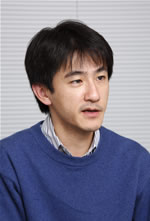2010/09/03
Making parallel processing available to everyone
Associate Professor Kenjiro Taura
(Department of Information and Communication Engineering)

Associate Professor Taura focuses on empowering people to access parallel processing at any time by connecting multiple computers. He aims to develop parallel processing software for distributed computing environments that can be used as a single supercomputer by connecting multiple computers in different locations through a network and assigning computers jobs to be simultaneously processed in parallel.
Although parallel processing provides benefits of high-speed and high-throughput, its usage is still limited as in large-scale scientific computation.¬† In order to promote its wide adoption, it is necessary to develop software for grid environment such as programming languages that give instructions to make full use of computers with different performance.¬† Associate Professor Taura strives to realize a ‚Äúsimple edition of parallel processing‚ÄĚ that can be easily executed with regular OS and familiar programming languages without complex processing management, and decided to focus on script language that is used by many programmers.¬† He led collaborative research to virtually create a distributed computing environment connecting approximately 500 computers at the University of Tokyo, National Institute of Informatics, Kyoto University, Tokyo Institute of Technology, and Waseda University to analyze medical texts at ultra-high speed using script language.
Significant improvement in computer processing performance brought changes to computing environment.  There is an idle time as normal computation does not require full performance.  Associate Professor Taura paved the way to share the idle time for other large-scale computational processing such as meteorological, gene, and protein analysis.  This new processing model attracts attention towards the information explosion era since it is applicable not only to scientific computation but also to information search, natural language processing, and data mining with an effective use of computer resource.

